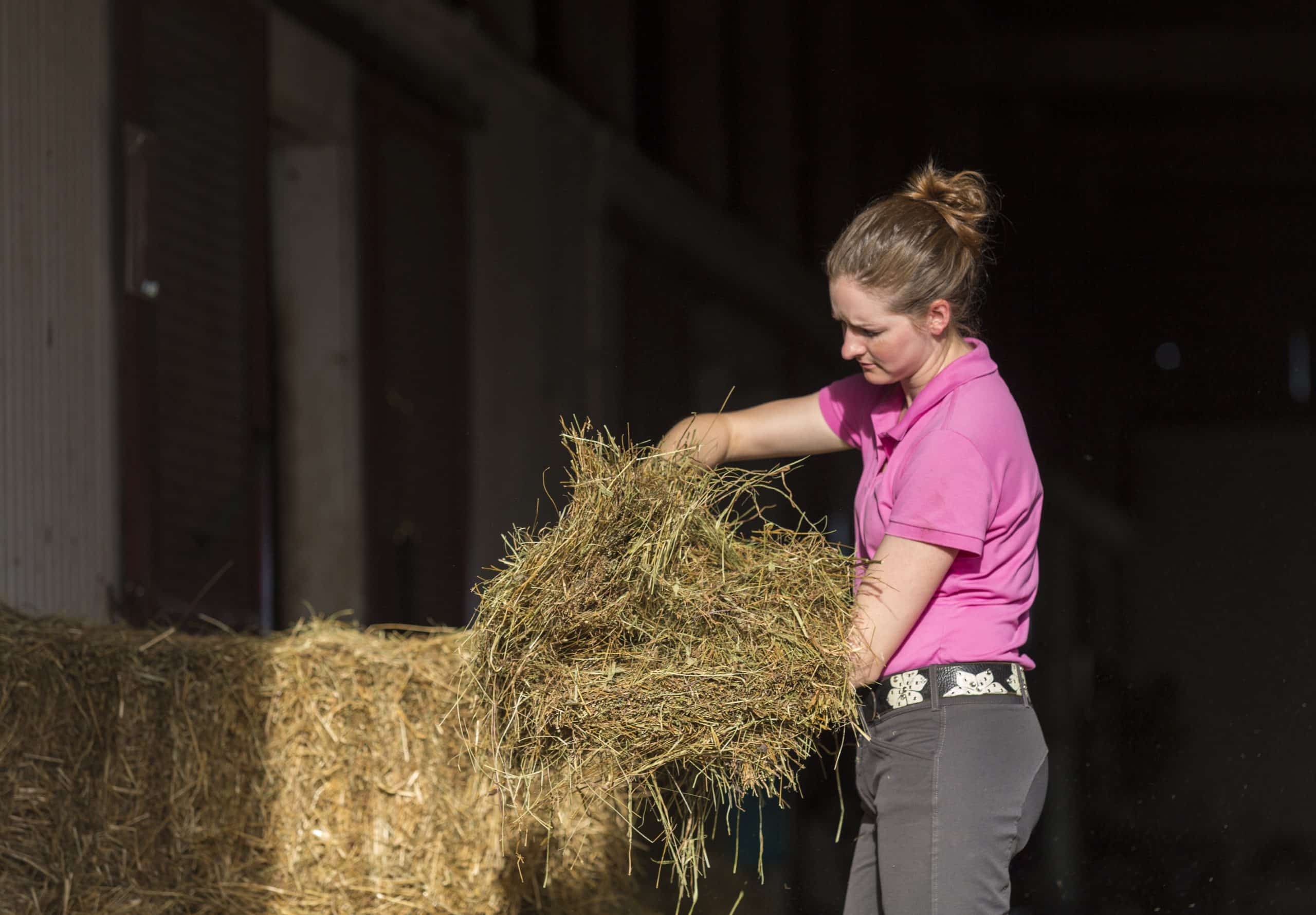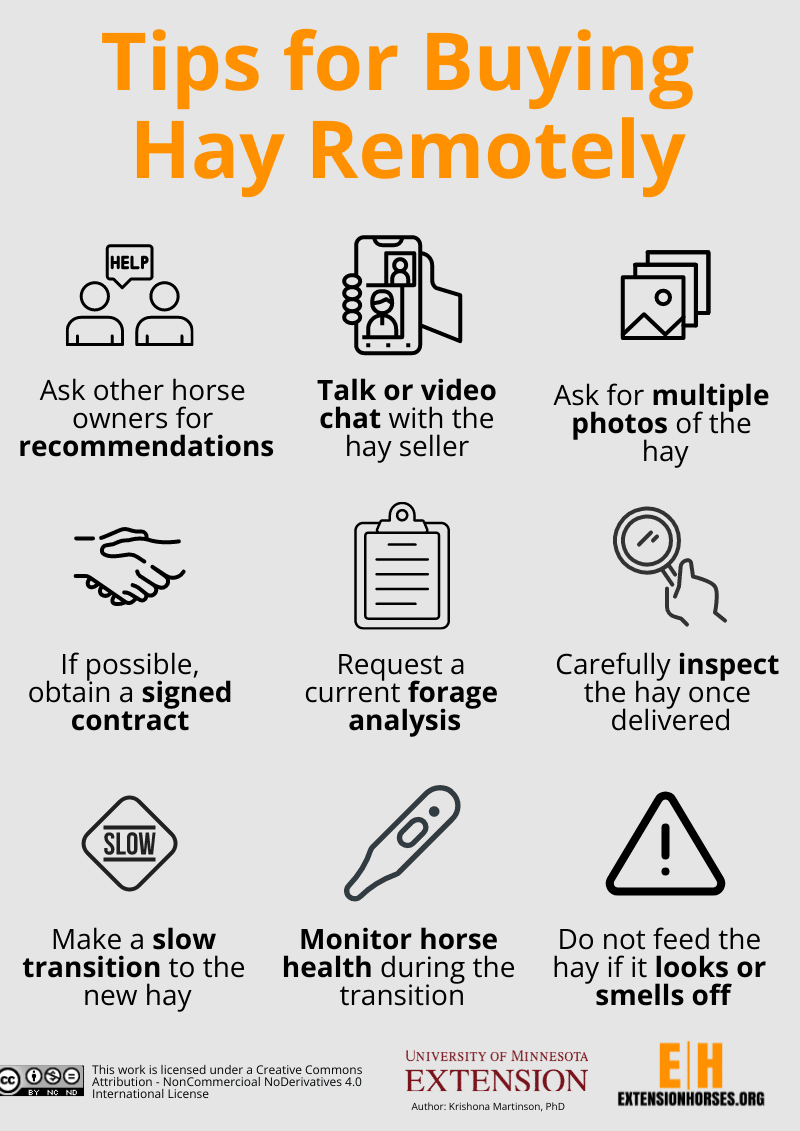
If possible, inspect the hay before purchasing it. Feeling the hay allows you to determine how soft or stemmy it is and predict if your horses will consume it readily. Photo: Kevin Thompson
When an athlete retires, many things start to change: No more presunrise wakeup calls, no more structured workouts, no more need for extra supplements. These changes then alter the composition of the athlete’s body from a lean, fit machine to something a little softer.
Transitioning an off-track Thoroughbred from the world of horse racing to a more leisurely or competitive career requires careful attention to every aspect of his care, especially his nutrition. Just like retired human athletes, these horses need a diet that supports their new lifestyle while helping maintain their health and vitality. Hay stands as a cornerstone in their diets, providing essential nutrients and fiber crucial for digestion and overall well-being.
However, not all hay is created equal, and selecting the right type can significantly impact your horse’s performance and longevity. In this guide we’ll explore the intricacies of choosing the perfect hay for your off-track Thoroughbred and offer important nutritional insights to ensure your horse thrives in his post-racing journey.
Common Types of Hay for Horses
Generally, hay can be grouped into three different types: legumes, grass and mixed. Mixed combines legumes and grasses or blends different types of grasses. Each type has its own mix of nutrients that can be beneficial for all horses.
Legumes Alfalfa is the most popular type of legume hay and the one that is most often mixed with grass hay. Other types of legumes include red clover, birdsfoot trefoil and even peanut hay. Alfalfa is abundant in calcium and protein.
“Like all legumes, alfalfa is high in protein, but it’s also high in energy,” says Kris Hiney, PhD, extension specialist at Oklahoma State University, in Stillwater. “It is typically higher in energy compared to other forages, and, of course, the stage of maturity plays a role.”
Very mature hay can be as little as 12-13% crude protein, whereas high-quality alfalfa hay can be as much as 20-24%, Hiney says. “So, midrange we typically think of 15-18% crude protein. For calcium, the amount is as low as 1% to as high as 4%. This is why for bulk feeding or buying in large lots it is useful to have a forage analysis.”
Grass hays are divided into two basic groups: cool-season and warm-season grasses. Cool-season grasses include timothy, orchardgrass, fescue and bluegrass, among others. Warm-season grasses include Bermuda grass, switchgrass and teff. Extension agents and nutritionists say timothy grass hay is the most popular among horse owners and their horses because of its high palatability. Managers of breeding facilities mostly avoid planting fescue because if it has been infected with an endophyte fungus, it can be detrimental to a pregnant mare’s fetus.
Choosing Hay for Your OTTB
While many hays appear the same, nutrient content and palatability can vary widely depending on the region, time of year and weather. In general, cool-season grass hays are higher in nutrient content than warm-season grass hays.
When you’re looking at choosing hay at cutting, an “immature hay” means the plant was younger when it was cut. The younger it is, the higher its nutrient density.
“So, for picky eaters, I would want to find a hay that is softer, green-leafed and pliable,” says Hiney. “All of that is what you’ll find in a more immature hay.”
Older, more mature hay contains more fiber and less protein and other important nutrients. If you have horses with lower energy requirements you can feed lower-quality hay, but lower-quality only in terms of maturity—not relative to weeds, mold and other characteristics, Hiney says. Your hay producer should be able to tell you the stage of maturity and quality of the hay.
So how can you choose horse hay to purchase?
Hiney stresses the importance of inspecting the hay in person. Feeling the hay allows you to determine how soft or stemmy it is and predict if your horses will consume it readily.
The best assessment, however, is to test it. If you’re purchasing hay in bulk (more than 50 bales at a time), this is how you will be sure you’re getting a good-quality batch. It will also let you know the nutrient levels it contains so you can build the rest of your horses’ diets around it.
You can recruit your local extension agent to help you with this process. Using a hay probe, you’ll take a core sample of multiple bales. “The idea is that you will do multiple bales within a lot, so it represents a field, more or less,” explains Hiney. “It takes samples across a bigger area of the field. You’re going through the bale, so you might be sampling 20 feet of a hay field, and you’re doing it in multiple bales, so you’re getting spot checks of that hay field. So, it gives you a better idea of what’s there, versus just one sample.”

If shopping for hay in-person is not possible, follow these tips for buying hay remotely. Courtesy Dr. Kris Hiney
What’s the difference between first-cutting and second-cutting hays for horses?
Many horse owners put weight into the hay’s cutting number and seek hay advertised as “first cutting” or “second cutting.” It can be confusing to think about which is better — earlier cuttings or later?
“If you were to walk a pasture in early spring, think about what’s growing right now more vigorously than the rest. That would be weeds,” says Hiney. “Typically, the grass is not as robust in the first cutting because of the weather. Everything is a little slower to get going in the beginning, so often those plants will have to reach a greater maturity before they’re tall enough for harvest.
“I would never say that the first cutting is bad or that there is anything wrong with it, it just depends on the horse that you’re feeding,” she continues. “If you’re feeding some horses that do nothing (and, so, have lower calorie requirements), then it’s fine. You just need to work with your hay producer to see what’s happening with the fields (if you have a harder-keeping horse).”
She also adds that while the first cutting might tend to be lower quality, if your hay producer uses herbicides, the weeds won’t be an issue.
To Mix or Not to Mix Horse Hay?
Horse owners hold different opinions as to whether feeding mixed hay (often a legume and a grass) is worth the investment. Again, this depends on your location and where you get your hay.
“This is where working with your hay producer is super important,” says Hiney.
In the South it’s rare to find a mixed field — it’s mostly straight alfalfa. However further north you’ll find alfalfa mixed with cool-season grasses more often than straight alfalfa fields.
“I would say that straight alfalfa is probably not necessary for many horses, especially those off the track,” says Hiney, because many don’t need a hay that calorie-dense. “Mixed hay is a great idea if it’s available to you,” she adds. “That can be hard because it’ll depend on where you live and what the weather did that year.”
Indeed, weather can have a big impact on the types of hay grown, the quality upon harvest and, of course, the price. “When we have a drought (in Oklahoma), it’s hard on a lot of horse owners around here, and they have to ship in hay,” she explains.
If you’re looking to have hay shipped in from a remote location, Hiney points out you’re more likely to get types of hay you’re not used to feeding. If you work with a hay producer, he or she should be able to connect you with another producer to fulfill your order.
Matching Workload With Hay Load
You likely already know about calories-in, calories-out. While people typically refer to human fitness and health when they say this, it’s a good principle to keep in mind with horses and their nutrient needs.
Racing Thoroughbreds have extremely high energy demands that shift when they retire. “If you’ve taken them off the track, and there’s a phase of the horse not doing much, whether that’s as part of the retraining process, then those horses do not require the same amount of energy as they did on the track,” Hiney explains.
She recommends utilizing the Henneke Body Condition Scoring scale as your guide to how much you’re feeding your OTTB. “That’ll tell you if he needs more calories or not,” she says.
She also notes that with retired racehorses, the other thing to think about is their mental health — they could need a little decompression time, or they might have gastric ulcers. It’s important to solve those issues (consult a veterinarian about the latter) so they can thrive. You’ll see many owners and trainers offer OTTBs hay in a slow feeder to increase the length of time eating and prevent boredom.
In general, Hiney feels people tend to overestimate protein requirements for exercising horses, when the primary factor is often calories. No matter the discipline after racing, most OTTBs won’t be subject to the same oxidative stress as they were on the track, so owners can dial back their nutrition. But that depends on what you have decided to do with your OTTB. If he’ll be an eventer, he has an intense job ahead of him, so he’ll be closer to his old lifestyle than a horse retraining as a 2’ hunter or a trail horse.
Ultimately, it’s important to consider a horse’s current activity level, body condition and nutrient requirements when designing his diet.
Take-Home Message
Optimal nutrition is paramount to your off-track Thoroughbred’s health and performance. Among the essential components of his diet, hay plays a foundational role, providing vital nutrients and fiber necessary for digestive health, athletic performance and overall well-being.

